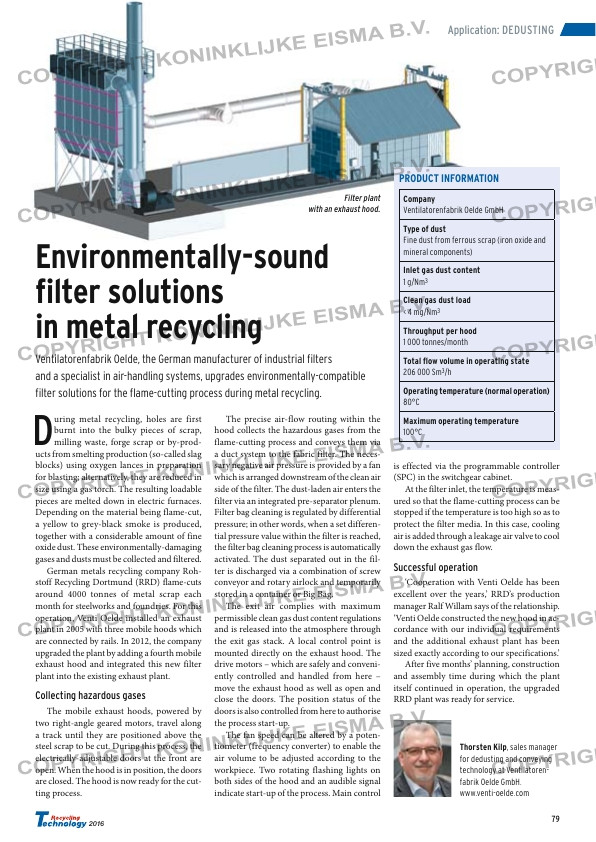Page 79 from: Recycling Technology 2016

79
2016
Application: DEDUSTING
Environmentally-sound
filter solutions
in metal recycling
Ventilatorenfabrik Oelde, the German manufacturer of industrial filters
and a specialist in air-handling systems, upgrades environmentally-compatible
filter solutions for the flame-cutting process during metal recycling.
D
uring metal recycling, holes are first
burnt into the bulky pieces of scrap,
milling waste, forge scrap or by-prod-
ucts from smelting production (so-called slag
blocks) using oxygen lances in preparation
for blasting; alternatively, they are reduced in
size using a gas torch. The resulting loadable
pieces are melted down in electric furnaces.
Depending on the material being flame-cut,
a yellow to grey-black smoke is produced,
together with a considerable amount of fine
oxide dust. These environmentally-damaging
gases and dusts must be collected and filtered.
German metals recycling company Roh-
stoff Recycling Dortmund (RRD) flame-cuts
around 4000 tonnes of metal scrap each
month for steelworks and foundries. For this
operation, Venti Oelde installed an exhaust
plant in 2005 with three mobile hoods which
are connected by rails. In 2012, the company
upgraded the plant by adding a fourth mobile
exhaust hood and integrated this new filter
plant into the existing exhaust plant.
Collecting hazardous gases
The mobile exhaust hoods, powered by
two right-angle geared motors, travel along
a track until they are positioned above the
steel scrap to be cut. During this process, the
electrically-adjustable doors at the front are
open. When the hood is in position, the doors
are closed. The hood is now ready for the cut-
ting process.
The precise air-flow routing within the
hood collects the hazardous gases from the
flame-cutting process and conveys them via
a duct system to the fabric filter. The neces-
sary negative air pressure is provided by a fan
which is arranged downstream of the clean air
side of the filter. The dust-laden air enters the
filter via an integrated pre-separator plenum.
Filter bag cleaning is regulated by differential
pressure; in other words, when a set differen-
tial pressure value within the filter is reached,
the filter bag cleaning process is automatically
activated. The dust separated out in the fil-
ter is discharged via a combination of screw
conveyor and rotary airlock and temporarily
stored in a container or Big Bag.
The exit air complies with maximum
permissible clean gas dust content regulations
and is released into the atmosphere through
the exit gas stack. A local control point is
mounted directly on the exhaust hood. The
drive motors – which are safely and conveni-
ently controlled and handled from here –
move the exhaust hood as well as open and
close the doors. The position status of the
doors is also controlled from here to authorise
the process start-up.
The fan speed can be altered by a poten-
tiometer (frequency converter) to enable the
air volume to be adjusted according to the
workpiece. Two rotating flashing lights on
both sides of the hood and an audible signal
indicate start-up of the process. Main control
is effected via the programmable controller
(SPC) in the switchgear cabinet.
At the filter inlet, the temperature is meas-
ured so that the flame-cutting process can be
stopped if the temperature is too high so as to
protect the filter media. In this case, cooling
air is added through a leakage air valve to cool
down the exhaust gas flow.
Successful operation
‘Cooperation with Venti Oelde has been
excellent over the years,’ RRD’s production
manager Ralf Willam says of the relationship.
‘Venti Oelde constructed the new hood in ac-
cordance with our individual requirements
and the additional exhaust plant has been
sized exactly according to our specifications.’
After five months’ planning, construction
and assembly time during which the plant
itself continued in operation, the upgraded
RRD plant was ready for service.
PRODUCT INFORMATION
Company
Ventilatorenfabrik Oelde GmbH
Type of dust
Fine dust from ferrous scrap (iron oxide and
mineral components)
Inlet gas dust content
1 g/Nm3
Clean gas dust load
< 4 mg/Nm3
Throughput per hood
1 000 tonnes/month
Total flow volume in operating state
206 000 Sm3/h
Operating temperature (normal operation)
80°C
Maximum operating temperature
100°C
Filter plant
with an exhaust hood.
Thorsten Kilp, sales manager
for dedusting and conveying
technology at Ventilatoren-
fabrik Oelde GmbH.
www.venti-oelde.com



